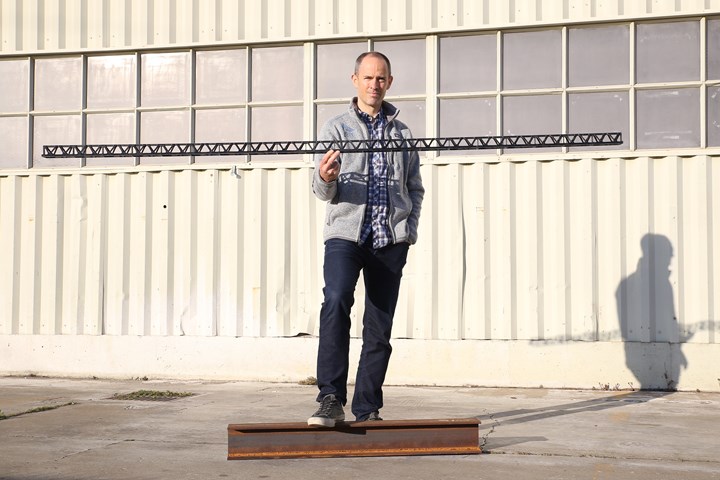Q&A with Ethan Escowitz, CEO, Arris Composites
Ethan Escowitz visits with CW Talks to discuss Arris Composites’ Additive Molding process.

Ethan Escowitz, CEO and co-founder of Arris Composites, holds a truss structure made using the company’s Additive Molding process. Photo Credit: Arris Composites
Ethan Escowitz, CEO and co-founder of Arris Composites (Berkeley, Calif., U.S.) talked recently with CW editor-in-chief Jeff Sloan about Arris, its Additive Molding technology and how it’s being deployed into the marketplace. That discussion is excerpted here, but if you want to hear the entire interview on the CW Talks podcast, please visit compositesworld.com/podcast or download CW Talks from Apple Podcasts or Google Podcasts.
JS: I know that what Arris has developed [Additive Molding] is maybe technically additive manufacturing, but it's different from what we traditionally consider as additive manufacturing, right?
EE: Essentially, our electromechanical system produces these near net shape, complex, continuous fiber, preform assemblies, and then we mold them in a post-processing step.
JS: So, you are preforming dry or prepreg fibers directly into a mold?
EE: We use thermoplastic composites that are pre-impregnated.
JS: And those are being automatically, or at least with some sort of automation, deposited into a mold and then transferred into a compression process, correct?
EE: Exactly.
JS: What do you see as the sweet spot for this process?
EE: Consumer electronics is really where we started because we're able to change the product architecture much faster there and and look at part consolidation. We are also looking at drop-in replacement parts in other spaces [vehicles]…We can make a lot of very valuable high-performance, small parts, and then for products that have larger architectures, consolidate the assembly….So, different strategies for different part classes.
JS: You mentioned a few applications in electronics, you also talked generally about automotive and aerospace. What are some examples of automotive or aerospace applications where this process is a good fit?
EE: In automotive and aerospace there are many structural brackets that are more complex in nature, and haven't seen is as much composite innovation, as the bigger, flatter 2D, 2.5D shapes. Metal 3D printing, for instance, has really popularized some of the topology-optimized brackets and shapes that that are possible to manufacture with those methods… So, many of those structural brackets really are the ideal shape. And our ability to align fibers through that 3D structure running along the load paths of the part has been able to save substantial weight over the metal 3D printing and be very cost competitive.
JS: Arris presented a paper at CAMX 2020 on the convergence of composites and topology optimization. The paper basically describes work that Arris did with Northrop Grumman to take a metallic bracket and redesign it and optimize it for manufacture using the Arris Additive Molding process. Can you talk more about this?
EE: [With this project] we're equaling the stiffness of 3D printed titanium at an 80% weight savings. And as I'm sure many listeners know, in any aircraft, you might have hundreds of brackets. So reducing this much weight really speaks to the ability to put these continuous composites into complex shapes. And this really clearly illustrates where the commercial value exists for aircraft manufacturers and owners. Obviously, as we we talked about earlier as well, brackets are not unique to aerospace.
Related Content
-
PEEK vs. PEKK vs. PAEK and continuous compression molding
Suppliers of thermoplastics and carbon fiber chime in regarding PEEK vs. PEKK, and now PAEK, as well as in-situ consolidation — the supply chain for thermoplastic tape composites continues to evolve.
-
Materials & Processes: Composites fibers and resins
Compared to legacy materials like steel, aluminum, iron and titanium, composites are still coming of age, and only just now are being better understood by design and manufacturing engineers. However, composites’ physical properties — combined with unbeatable light weight — make them undeniably attractive.
-
Infinite Composites: Type V tanks for space, hydrogen, automotive and more
After a decade of proving its linerless, weight-saving composite tanks with NASA and more than 30 aerospace companies, this CryoSphere pioneer is scaling for growth in commercial space and sustainable transportation on Earth.


















.jpg;maxWidth=300;quality=90)

